分布式驱动纯电动汽车的协调主动控制、关键技术及问题探讨
- 格式:pptx
- 大小:23.24 MB
- 文档页数:36
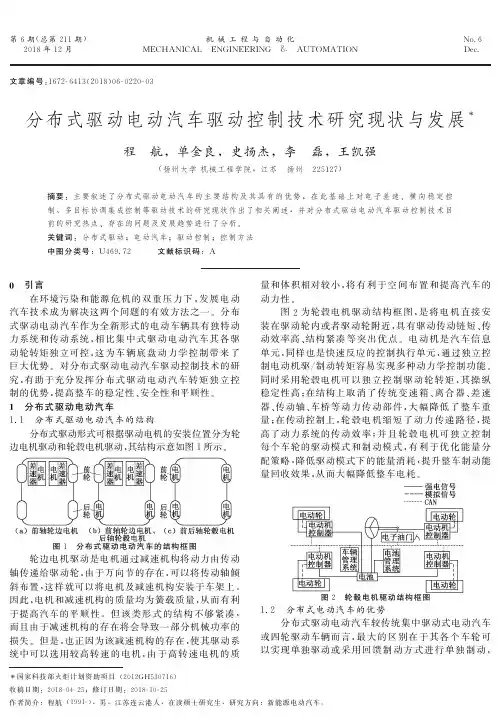
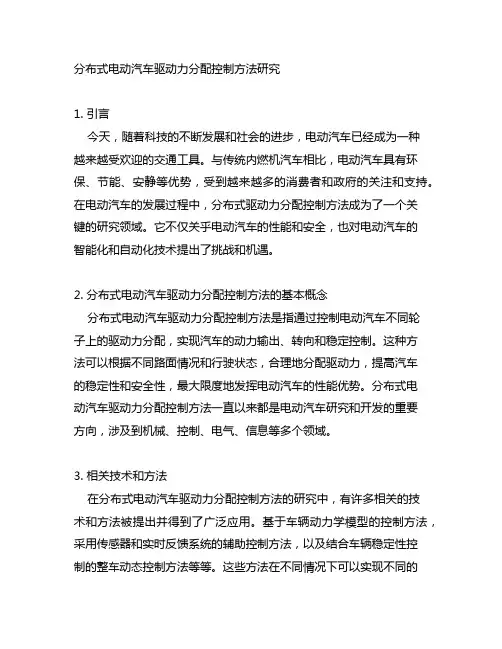
分布式电动汽车驱动力分配控制方法研究1. 引言今天,随着科技的不断发展和社会的进步,电动汽车已经成为一种越来越受欢迎的交通工具。
与传统内燃机汽车相比,电动汽车具有环保、节能、安静等优势,受到越来越多的消费者和政府的关注和支持。
在电动汽车的发展过程中,分布式驱动力分配控制方法成为了一个关键的研究领域。
它不仅关乎电动汽车的性能和安全,也对电动汽车的智能化和自动化技术提出了挑战和机遇。
2. 分布式电动汽车驱动力分配控制方法的基本概念分布式电动汽车驱动力分配控制方法是指通过控制电动汽车不同轮子上的驱动力分配,实现汽车的动力输出、转向和稳定控制。
这种方法可以根据不同路面情况和行驶状态,合理地分配驱动力,提高汽车的稳定性和安全性,最大限度地发挥电动汽车的性能优势。
分布式电动汽车驱动力分配控制方法一直以来都是电动汽车研究和开发的重要方向,涉及到机械、控制、电气、信息等多个领域。
3. 相关技术和方法在分布式电动汽车驱动力分配控制方法的研究中,有许多相关的技术和方法被提出并得到了广泛应用。
基于车辆动力学模型的控制方法,采用传感器和实时反馈系统的辅助控制方法,以及结合车辆稳定性控制的整车动态控制方法等等。
这些方法在不同情况下可以实现不同的优势,有助于提高电动汽车的动态性能和安全性能。
4. 分布式电动汽车驱动力分配控制方法的挑战与发展然而,分布式电动汽车驱动力分配控制方法也面临着一些挑战。
如何实现对电动汽车不同轮子上的驱动力精确控制是一个复杂的技术问题,需要借助先进的传感器技术和控制算法。
分布式电动汽车驱动力分配控制方法的研究需要跨学科的合作和交叉融合,这对研究团队和研究人员的综合素质提出了更高的要求。
随着电动汽车技术的不断发展和市场需求的不断增长,分布式电动汽车驱动力分配控制方法将会迎来新的发展机遇和挑战。
5. 个人观点和理解对于分布式电动汽车驱动力分配控制方法,我认为它是电动汽车技术发展过程中的一个重要环节,关系到电动汽车的性能和安全。


分布式驱动电动汽车驱动控制技术研究综述贾婕;赵景波;杨超越;陈云飞【摘要】分布式驱动电动汽车具有控制灵活、控制响应快等优势,越来越受到人们的关注.文章叙述了分布式驱动电动汽车驱动控制技术的研究现状,重点介绍了电子差速控制、横摆力矩控制、多目标协调集成控制和容错控制等控制技术的研究方法以及国内外研究现状,并对当前存在的问题及发展趋势进行了分析.【期刊名称】《常州工学院学报》【年(卷),期】2019(032)002【总页数】6页(P1-6)【关键词】分布式驱动;电动汽车;驱动控制;智能控制【作者】贾婕;赵景波;杨超越;陈云飞【作者单位】江苏理工学院 ,江苏常州 213001;江苏省新能源汽车动力系统集成控制重点建设实验室 ,江苏常州 213001;常州工学院 ,江苏常州 213032;江苏理工学院 ,江苏常州 213001;江苏省新能源汽车动力系统集成控制重点建设实验室 ,江苏常州 213001;江苏理工学院 ,江苏常州 213001;江苏省新能源汽车动力系统集成控制重点建设实验室 ,江苏常州 213001【正文语种】中文【中图分类】U469.72近年来,由于能源危机和环境问题,电动汽车逐渐成为研究热点。
电机和电机控制器技术的改进,为多种动力传动系统配置提供了更多的可能。
随着对电动汽车的深入研究,分布式驱动电动汽车开始备受关注。
它通过4个轮边电机分别驱动4个车轮实现独立控制。
该结构具有转矩响应速度快、精度高以及单个电机独立可控等优点,为车辆底盘的动力学控制提供了广阔的前景。
对分布式驱动电动汽车驱动控制技术进行研究,充分利用其独立驱动等优势,对改善车辆的动力性能以及稳定性、安全性具有重大意义。
1 分布式驱动电动汽车的优势相比于传统汽车以及中央驱动的电动汽车,分布式驱动电动汽车具有较大的优势和潜力。
1)取消了大部分的传动结构,减少车辆底盘部件数量,节省底盘空间,为实现整车轻量化带来了可能。
与集中驱动的车辆相比,可以获得更大的能量回收率,能够有效提高电动汽车的续航里程。

分布式电动汽车驱动力分配控制方案研究分布式电动汽车驱动力分配控制方案研究步骤一:分析分布式电动汽车驱动力分配的需求在研究分布式电动汽车驱动力分配控制方案之前,首先需要明确其需求。
分布式电动汽车指的是一种由多个电动汽车组成的网络系统,这些电动汽车可以相互通信和协调,以实现更高效的驱动力分配。
因此,我们需要明确以下需求:1. 能够根据电动汽车的当前状态和任务需求,动态分配驱动力。
2. 能够实时获取电动汽车的状态信息,并对其进行处理和分析。
3. 能够通过网络和通信技术,实现电动汽车之间的协调和通信。
步骤二:调研已有的分布式电动汽车驱动力分配控制方案在进行自己的研究之前,我们需要对已有的分布式电动汽车驱动力分配控制方案进行调研。
这包括查阅相关的学术论文、专利和技术文档,以了解目前已有的技术和解决方案。
在调研的过程中,需要注意以下几点:1. 查找与分布式电动汽车驱动力分配控制相关的研究论文和专利。
2. 了解已有的分布式电动汽车驱动力分配控制方案的原理和实现方法。
3. 分析已有方案的优缺点,以及其适用的场景和条件。
步骤三:制定分布式电动汽车驱动力分配控制方案基于需求分析和已有方案的调研结果,我们可以开始制定自己的分布式电动汽车驱动力分配控制方案。
在制定方案时,需要注意以下几点:1. 根据电动汽车的状态信息和任务需求,确定驱动力分配的算法和策略。
这可能涉及到优化算法、协调控制策略或者混合方法。
2. 设计驱动力分配的控制器和通信模块,以实现电动汽车之间的协调和通信。
3. 考虑安全性和实时性的需求,设计相应的控制和通信机制。
步骤四:仿真和实验验证制定完分布式电动汽车驱动力分配控制方案后,需要进行仿真和实验验证。
通过仿真和实验,可以评估方案的性能和效果,并根据结果进行优化和改进。
在进行仿真和实验时,需要注意以下几点:1. 选择合适的仿真平台或实验设备,以模拟真实的分布式电动汽车网络系统。
2. 设置合理的实验场景和参数,以测试方案在不同条件下的性能。
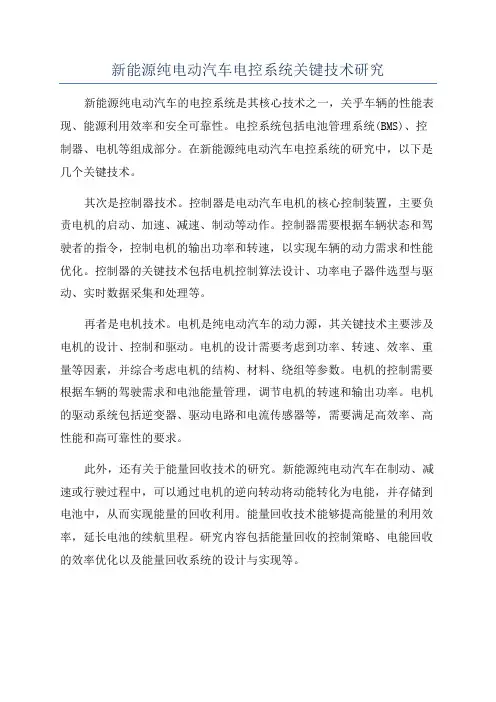
新能源纯电动汽车电控系统关键技术研究新能源纯电动汽车的电控系统是其核心技术之一,关乎车辆的性能表现、能源利用效率和安全可靠性。
电控系统包括电池管理系统(BMS)、控制器、电机等组成部分。
在新能源纯电动汽车电控系统的研究中,以下是几个关键技术。
其次是控制器技术。
控制器是电动汽车电机的核心控制装置,主要负责电机的启动、加速、减速、制动等动作。
控制器需要根据车辆状态和驾驶者的指令,控制电机的输出功率和转速,以实现车辆的动力需求和性能优化。
控制器的关键技术包括电机控制算法设计、功率电子器件选型与驱动、实时数据采集和处理等。
再者是电机技术。
电机是纯电动汽车的动力源,其关键技术主要涉及电机的设计、控制和驱动。
电机的设计需要考虑到功率、转速、效率、重量等因素,并综合考虑电机的结构、材料、绕组等参数。
电机的控制需要根据车辆的驾驶需求和电池能量管理,调节电机的转速和输出功率。
电机的驱动系统包括逆变器、驱动电路和电流传感器等,需要满足高效率、高性能和高可靠性的要求。
此外,还有关于能量回收技术的研究。
新能源纯电动汽车在制动、减速或行驶过程中,可以通过电机的逆向转动将动能转化为电能,并存储到电池中,从而实现能量的回收利用。
能量回收技术能够提高能量的利用效率,延长电池的续航里程。
研究内容包括能量回收的控制策略、电能回收的效率优化以及能量回收系统的设计与实现等。
最后,还有关于车辆安全和通信技术的研究。
新能源纯电动汽车需要实现对车辆和驾驶者的安全保护,并与外部环境进行信息交互。
研究内容包括车辆安全防护系统的设计、车辆远程监控和故障诊断等应用技术。
总之,新能源纯电动汽车电控系统关键技术的研究旨在提高电动汽车的性能、能源利用效率和安全可靠性。
在电池管理系统、控制器、电机、能量回收、车辆安全和通信等方面的研究,将进一步推动新能源纯电动汽车技术的发展。
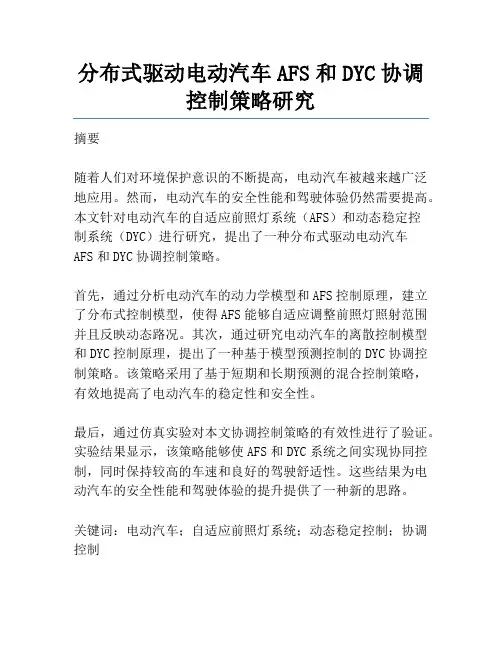
分布式驱动电动汽车AFS和DYC协调控制策略研究摘要随着人们对环境保护意识的不断提高,电动汽车被越来越广泛地应用。
然而,电动汽车的安全性能和驾驶体验仍然需要提高。
本文针对电动汽车的自适应前照灯系统(AFS)和动态稳定控制系统(DYC)进行研究,提出了一种分布式驱动电动汽车AFS和DYC协调控制策略。
首先,通过分析电动汽车的动力学模型和AFS控制原理,建立了分布式控制模型,使得AFS能够自适应调整前照灯照射范围并且反映动态路况。
其次,通过研究电动汽车的离散控制模型和DYC控制原理,提出了一种基于模型预测控制的DYC协调控制策略。
该策略采用了基于短期和长期预测的混合控制策略,有效地提高了电动汽车的稳定性和安全性。
最后,通过仿真实验对本文协调控制策略的有效性进行了验证。
实验结果显示,该策略能够使AFS和DYC系统之间实现协同控制,同时保持较高的车速和良好的驾驶舒适性。
这些结果为电动汽车的安全性能和驾驶体验的提升提供了一种新的思路。
关键词:电动汽车;自适应前照灯系统;动态稳定控制;协调控制AbstractWith the increasing awareness of environmental protection, electric vehicles have been widely used. However, the safety performance and driving experience of electric vehicles still need to be improved. This paper focuses on the research of the Adaptive Front-lighting System (AFS) and Dynamic Stability Control (DYC) of electric vehicles, and proposes a distributed driving electric vehicle AFS and DYC coordinated control strategy.Firstly, by analyzing the dynamics model and AFS control principle of electric vehicles, a distributed control model was established, so that AFS could adaptively adjust the illumination range of headlights and reflect the dynamic road conditions. Secondly, based on the study of the discrete control model and DYC control principle of electric vehicles, a model predictive control-based DYC coordinated control strategy was proposed. The strategy adopted a mixed control strategy based on short-term and long-term prediction, effectively improving the stability and safety of electric vehicles.Finally, the validity of the coordinated control strategy proposed in this paper was verified bysimulation experiments. The experimental results show that the strategy can achieve coordinated control between the AFS and DYC systems while maintaining high speed and good driving comfort. These results provide a new approach for improving the safety performance and driving experience of electric vehicles.Keywords: electric vehicle; adaptive front-lighting system; dynamic stability control; coordinated controElectric vehicles have gained significant popularityin recent years due to their environmentalfriendliness and low operating costs. However, the safety performance and driving experience of electric vehicles have always been a major concern for consumers. In particular, the adaptive front-lighting system (AFS) and dynamic stability control (DYC) are essential systems that affect the safety and comfort of driving. Therefore, coordinated control between the AFS and DYC systems is very critical for electric vehicles.Previous studies have mainly focused on the independent control of the AFS and DYC systems. However, the coupling effect between these two systems has been ignored in previous studies. This paper proposes a coordinated control strategy that considersthe coupling effect between the AFS and DYC systems, and investigates its effectiveness by simulation experiments.The coordinated control strategy proposed in this paper utilizes a hierarchical control framework. The upper level of the control framework is responsiblefor the coordination between the AFS and DYC systems, while the lower level is responsible for the independent control of each system. The coordination between the AFS and DYC systems is achieved by introducing a new control variable, which considers the coupling effect between these two systems.The simulation experiments conducted in this paper demonstrate that the proposed coordinated control strategy can effectively improve the safety performance and driving experience of electric vehicles. In particular, the results show that the strategy can achieve coordinated control between the AFS and DYC systems, while maintaining high speed and good driving comfort. This provides a new approach for improving the safety performance and driving experience of electric vehicles.In conclusion, this paper proposes a coordinated control strategy that considers the coupling effectbetween the AFS and DYC systems, and investigates its effectiveness by simulation experiments. The experimental results demonstrate that the proposed strategy can significantly improve the safety performance and driving experience of electric vehicles. Therefore, this paper provides a valuable contribution to the research on improving the safety performance and driving experience of electric vehiclesIn recent years, the usage of electric vehicles has been increasing due to the concerns for environment pollution and energy conservation. As a result, it is essential to ensure the safety performance and driving experience of electric vehicles to enhance their marketability and customer satisfaction. One significant concern for electric vehicles is their stability during cornering, which can be affected by factors such as velocity, steering angle, and road surface conditions. Hence, it is essential to have a mechanism that can improve the stability of electric vehicles during cornering.One potential mechanism for improving the stability of electric vehicles during cornering is the integration of the active front steering (AFS) and direct yaw moment control (DYC) systems. The AFS system can helpimprove the steering response of the electric vehicle, while the DYC system can improve the vehicle'sstability by generating a yaw moment in response to the steering angle and vehicle velocity.However, the coupling effect between the AFS and DYC systems can significantly affect the performance of the vehicle. Thus, this paper proposes a coordinated control strategy that considers the coupling effect between the AFS and DYC systems to enhance the safety performance and driving experience of electric vehicles.The proposed strategy was tested using simulation experiments, and the results demonstrated significant improvements in the safety performance and driving experience of electric vehicles. Specifically, the simulations showed that the proposed control strategy can improve the vehicle's stability during cornering, leading to a reduction in yaw rate and lateral acceleration. Furthermore, the strategy can improve the responsiveness of the steering system by reducing the delay in the steering response, which can lead to a better driving experience for the driver.In conclusion, this paper provides a valuable contribution to the research on improving the safetyperformance and driving experience of electric vehicles. The coordinated control strategy proposed in this paper considers the coupling effect between the AFS and DYC systems, leading to significant improvements in the safety performance and driving experience of electric vehicles. Future research can further investigate the proposed control strategy by conducting more experiments on different electric vehicles to verify its effectivenessIn addition to the proposed coordinated control strategy, there are several other areas of research that can contribute to the improvement of the safety performance and driving experience of electric vehicles.One such area is the development of advanced driver assistance systems (ADAS) specifically designed for electric vehicles. ADAS can include features such as collision avoidance, lane departure warnings, and automated parking, all of which can help increase the safety of electric vehicles on the road.Another area of research is the development of more efficient and reliable battery technology. Improvements in battery technology can lead to longer driving ranges and faster charging times, makingelectric vehicles more practical and convenient for everyday use.Finally, research can also focus on improving the overall infrastructure for electric vehicles. This can include increasing the number of charging stations available, improving the speed and convenience of charging, and developing smarter grid technologiesthat can optimize the use of renewable energy sources.Overall, continued research and development in these areas can help increase the safety, efficiency, and convenience of electric vehicles, paving the way for a more sustainable and environmentally friendly transportation systemIn conclusion, electric vehicles have the potential to significantly reduce greenhouse gas emissions from transportation, but there are still challenges that need to be addressed to fully realize their benefits. Improving battery technology, increasing the range of vehicles, and developing smart charging and grid technologies are all important areas for research and development. Additionally, infrastructure improvements such as increasing the number and convenience of charging stations can help support the growth of electric vehicles. By addressing these challenges andinvesting in the continued development of electric vehicle technology, we can create a more sustainable and environmentally friendly transportation system。
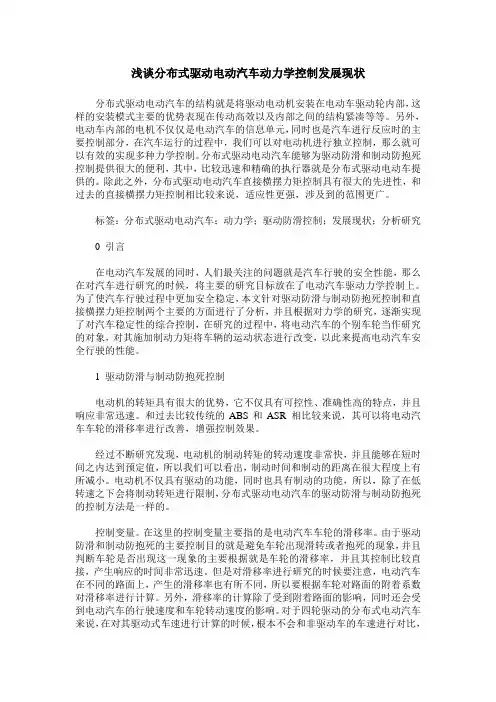
浅谈分布式驱动电动汽车动力学控制发展现状分布式驱动电动汽车的结构就是将驱动电动机安装在电动车驱动轮内部,这样的安装模式主要的优势表现在传动高效以及内部之间的结构紧凑等等。
另外,电动车内部的电机不仅仅是电动汽车的信息单元,同时也是汽车进行反应时的主要控制部分,在汽车运行的过程中,我们可以对电动机进行独立控制,那么就可以有效的实现多种力学控制。
分布式驱动电动汽车能够为驱动防滑和制动防抱死控制提供很大的便利,其中,比较迅速和精确的执行器就是分布式驱动电动车提供的。
除此之外,分布式驱动电动汽车直接横摆力矩控制具有很大的先进性,和过去的直接横摆力矩控制相比较来说,适应性更强,涉及到的范围更广。
标签:分布式驱动电动汽车;动力学;驱动防滑控制;发展现状;分析研究0 引言在电动汽车发展的同时,人们最关注的问题就是汽车行驶的安全性能,那么在对汽车进行研究的时候,将主要的研究目标放在了电动汽车驱动力学控制上。
为了使汽车行驶过程中更加安全稳定,本文针对驱动防滑与制动防抱死控制和直接横摆力矩控制两个主要的方面进行了分析,并且根据对力学的研究,逐渐实现了对汽车稳定性的综合控制,在研究的过程中,将电动汽车的个别车轮当作研究的对象,对其施加制动力矩将车辆的运动状态进行改变,以此来提高电动汽车安全行驶的性能。
1 驱动防滑与制动防抱死控制电动机的转矩具有很大的优势,它不仅具有可控性、准确性高的特点,并且响应非常迅速。
和过去比较传统的ABS和ASR 相比较来说,其可以将电动汽车车轮的滑移率进行改善,增强控制效果。
经过不断研究发现,电动机的制动转矩的转动速度非常快,并且能够在短时间之内达到预定值,所以我们可以看出,制动时间和制动的距离在很大程度上有所减小。
电动机不仅具有驱动的功能,同时也具有制动的功能,所以,除了在低转速之下会将制动转矩进行限制,分布式驱动电动汽车的驱动防滑与制动防抱死的控制方法是一样的。
控制变量。
在这里的控制变量主要指的是电动汽车车轮的滑移率。
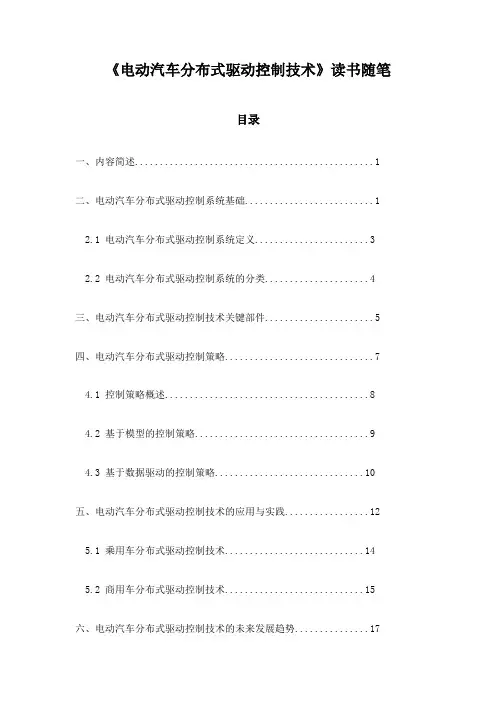
《电动汽车分布式驱动控制技术》读书随笔目录一、内容简述 (1)二、电动汽车分布式驱动控制系统基础 (1)2.1 电动汽车分布式驱动控制系统定义 (3)2.2 电动汽车分布式驱动控制系统的分类 (4)三、电动汽车分布式驱动控制技术关键部件 (5)四、电动汽车分布式驱动控制策略 (7)4.1 控制策略概述 (8)4.2 基于模型的控制策略 (9)4.3 基于数据驱动的控制策略 (10)五、电动汽车分布式驱动控制技术的应用与实践 (12)5.1 乘用车分布式驱动控制技术 (14)5.2 商用车分布式驱动控制技术 (15)六、电动汽车分布式驱动控制技术的未来发展趋势 (17)6.1 技术创新方向 (18)6.2 应用前景展望 (19)七、结论与建议 (21)一、内容简述《电动汽车分布式驱动控制技术》是一本深入探讨电动汽车分布式驱动控制技术的专业书籍。
本书系统地介绍了电动汽车分布式驱动控制的基本原理、关键技术、系统设计和实际应用等方面的内容,旨在为读者提供一个全面的电动汽车分布式驱动控制技术了解与参考。
我们首先对电动汽车分布式驱动控制技术进行了简要介绍,包括其定义、发展历程和在电动汽车领域的重要性。
我们详细阐述了电动汽车分布式驱动控制系统的工作原理,包括电机、电池、控制器等核心部件的功能和相互协作方式。
我们还讨论了电动汽车分布式驱动控制技术的多种实现方式,如机械式分布式驱动、电子式分布式驱动以及混合式分布式驱动等,并分析了它们各自的优缺点和适用场景。
本书不仅为读者提供了电动汽车分布式驱动控制技术的理论知识,还通过实例分析和实践指导,帮助读者更好地理解和掌握这一领域的核心技术。
无论是对于电动汽车行业的研发人员还是技术人员,本书都是一本极具价值的参考书籍。
二、电动汽车分布式驱动控制系统基础电动汽车分布式驱动控制系统,作为现代电动汽车的核心技术之一,其复杂性和先进性不言而喻。
随着科技的飞速发展,这一领域也在不断突破与革新。

分布式电驱动车辆动力学状态参数观测及驱动力协调控制共3篇分布式电驱动车辆动力学状态参数观测及驱动力协调控制1分布式电驱动车辆动力学状态参数观测及驱动力协调控制随着能源问题日益受到关注,新能源汽车的研究与应用也受到了广泛关注。
其中,分布式电驱动技术成为提高新能源汽车效能和降低能量消耗的重要手段。
分布式电驱动技术使得驱动力能够实时调节,车辆动力学状态得到优化,从而提高了效率和经济性。
分布式电驱动车辆动力学状态参数的观测是实现驱动力协调控制的关键。
在车辆行驶过程中,需要精确观测车辆的位置、速度、加速度等运动参数以及电池电量、电机温度等状态参数,来判断车辆当前状态和行驶情况,并及时做出调整。
观测参数的精度、灵敏度是实现驱动力协调控制的基石。
驱动力协调控制是实现优化车辆动力学状态的关键。
传统汽车采用单个发动机驱动,难以实现驱动力的精细控制;而分布式电驱动车辆由多个驱动单元组成,可以实现车轮的单独驱动和调节,从而具有更灵活的驱动力调节能力。
在车辆运行过程中,电子控制单元可以根据车辆的行驶条件和司机需求,对驱动单元进行自适应控制,从而实现最优化的驱动力配合和车辆动力学状态优化,提高了新能源汽车的性能和经济性。
然而,分布式电驱动技术在实际应用中也面临着一些挑战。
例如,分布式电驱动系统中的驱动单元控制算法需要更高的精度和灵敏度;车辆实际路况和驾驶习惯等因素变化较大,需要实时调整驱动力和动力学状态参数的观测和控制策略;驱动单元的故障检测同样需要更加精确且快速的反应能力。
为了解决上述问题,需要通过实践和研究不断改进和完善分布式电驱动技术。
具体而言,可以采用改进的驱动单元控制算法、多模型融合观测算法等手段,提高驱动单元的精度和灵敏度,同时可以通过加入车辆传感器网络,实时监测车辆状态,从而更精确地调整驱动力和动力学状态参数。
此外,还可以采用分布式电驱动系统的特点,将车辆的动力学状态参数分布式观测和控制,从而更好地实现故障检测和安全控制。
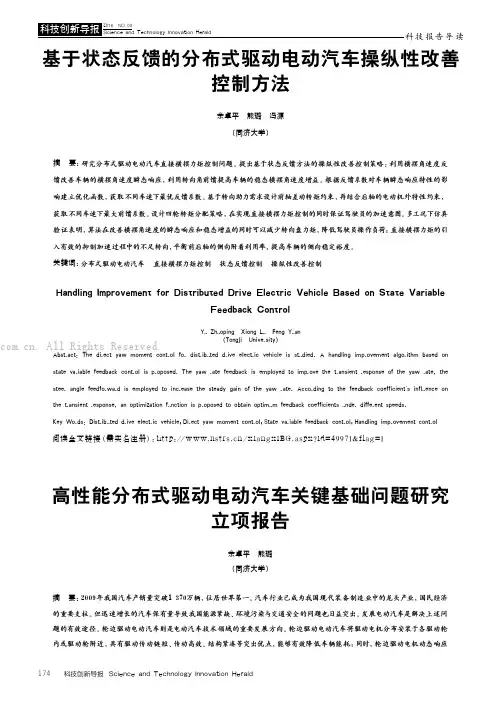
科技创新导报 Science and Technology Innovation Herald174技报告导读基于状态反馈的分布式驱动电动汽车操纵性改善控制方法余卓平 熊璐 冯源(同济大学)摘 要:研究分布式驱动电动汽车直接横摆力矩控制问题。
提出基于状态反馈方法的操纵性改善控制策略:利用横摆角速度反馈改善车辆的横摆角速度瞬态响应,利用转向角前馈提高车辆的稳态横摆角速度增益。
根据反馈系数对车辆瞬态响应特性的影响建立优化函数,获取不同车速下最优反馈系数。
基于转向助力需求设计前轴差动转矩约束,再结合后轴的电动机外特性约束,获取不同车速下最大前馈系数。
设计四轮转矩分配策略,在实现直接横摆力矩控制的同时保证驾驶员的加速意图。
多工况下仿真验证表明,算法在改善横摆角速度的瞬态响应和稳态增益的同时可以减少转向盘力矩,降低驾驶员操作负荷;直接横摆力矩的引入有效的抑制加速过程中的不足转向,平衡前后轴的侧向附着利用率,提高车辆的侧向稳定裕度。
关键词:分布式驱动电动汽车 直接横摆力矩控制 状态反馈控制 操纵性改善控制Handling Improvement for Distributed Drive Electric Vehicle Based on State VariableFeedback ControlYu Zhuoping Xiong Lu Feng Yuan(Tongji University)Abstract: The direct yaw moment control for distributed drive electric vehicle is studied. A handling improvement algorithm based on state variable feedback control is proposed. The yaw rate feedback is employed to improve the transient response of the yaw rate, the steer angle feedforward is employed to increase the steady gain of the yaw rate. According to the feedback coefficient's influence on the transient response, an optimization function is proposed to obtain optimum feedback coefficients under different speeds.Key Words: Distributed drive electric vehicle;Direct yaw moment control;State variable feedback control;Handling improvement control 阅读全文链接(需实名注册):htt p://w w w.nstr s.c n/x ian g x iBG.as px?id=49971&f lag=1高性能分布式驱动电动汽车关键基础问题研究立项报告余卓平 熊璐(同济大学)摘 要:2009年我国汽车产销量突破1 370万辆,位居世界第一。
分布式驱动新能源汽车驱动控制技术的发展及研究现状作者:于进川来源:《神州·下旬刊》2019年第10期摘要:分布式驱动新能源汽车是在环境污染和能源危机的双重压力下所研发出的新技术汽车,其相对于传统汽车优势明显,污染较低,且对不可再生能源的消耗较小。
本文对分布式驱动新能源汽车的控制技术进行了现状分析,阐述了驱动控制技术发展存在的问题,为驱动控制技术发展提供一定的借鉴意义。
关键词:分布式驱动;新能源汽车;驱动控制;控制方法引言人类的高速发展离不开能源的消耗,在消耗能源的同时,一方面加重了对环境的污染,另一方面也加快了地球上人类赖以生存的不可再生能源的消耗速度,因此,新能源汽车作为可以有效解决环境污染问题与能源危机问题的重要途径,是新时代汽车发展的趋势。
在新能源汽车发展过程中,出现了分布式驱动汽车,这种分布式驱动相比于传统电动汽车具有独特的动力系统与传动结构,在形式过程中各个驱动轮转矩独立可控,这就为新能源汽车底盘控制提供了便利。
在使用分布式驱动控制技术后,新能源汽车的稳定性大大提高,汽车形势的安全性与平顺性也大幅度提升。
1 分布式驱动新能源汽车1.1 分布式驱动新能源汽车的结构分布式驱动新能源汽车的结构与传统汽车不同,其特点为根据电机的安装位置分别安装轮边电机驱动与轮毂电机驱动,通过这样的方式,动力可以通过减速结构。
由传动轴传递给车轮,如图1所示。
电机和减速机构通过万向节的方式安装在车架上,所以这两部分的质量都成为了簧载质量,大大提高了车辆行驶的稳定性。
但是,在使用这种结构的情况下会导致车内电机与减速机构等装置缺乏紧凑性,而且在形式的过程中,减速机构会直接影响到机械的功率。
所以在使用分布式驱动结构时,使用的电机转速药膏,这样可以保证电机的质量较小,有利于结构的空间架构,而且高速电机能够大大提高汽车的动力。
轮毂电机驱动汽车相对于分布式驱动控制技术具有传动效率更高,结构更紧凑等特点。
轮毂电机驱动的信息单元为电动机,反应速度较快,操作稳定性较高,在整体结构框架内移除了传统汽车的变速箱与离合器、传动轴、差速器等传动装置,大大减少了车身的重量。
项目名称:高性能分布式驱动电动汽车关键基础问题研究首席科学家:余卓平同济大学起止年限:2010.9至2015.9依托部门:上海市科委二、预期目标3.1 总体目标本项目以分布式驱动电动汽车的节能与主动安全性能为突破点,建立基于分布式驱动电机特性的轮胎动态模型、车辆多体耦合动力学模型和动力电源—电驱动系统多场耦合动力学模型,构建分布式驱动电动汽车多体多场复杂耦合动力学系统;研究电源与电驱动系统能耗规律、车辆空气/热动力学特性及其能耗规律,提出分布式电源与能量管理系统的分析与设计理论、车身空气动力造型设计及整车结构设计方法与整车热管理方法;探索无非驱动轮工况下车辆关键动力学参数自适应辨识方法;研究复杂耦合系统能耗优化与动力学协调控制理论,创立高性能分布式驱动电动汽车设计与控制的新理论、新方法。
通过该重大基础研究项目的支持,可以培养一支以高性能分布式驱动电动汽车核心技术为研究背景的科研团队,产生一批具有国际影响力的中青年学术专家和具有自我创新能力的高水平骨干人才,提高我国汽车工业的自主研发水平,为我国电动汽车开发提供基础理论支持,推动我国汽车工业的跨越式发展。
3.2 五年预期目标(1)理论研究成果:揭示分布式驱动电机转矩与转速快速变化时的轮胎-路面的瞬态作用机理;揭示分布式驱动型式对电动汽车整车动力学的影响规律及多物理场的耦合作用对分布式驱动电动汽车动力学的影响规律。
揭示电源系统在全生命周期和全工作范围内的能量效率变化规律;建立适用于分布式驱动系统的电池状态估计理论模型,提出电池状态估计方法;揭示多样工况条件下不同拓扑结构电源与轮边电驱/制动系统能耗内在规律,提出电源及分布式电驱/制动系统拓扑结构理论及能量管理方法。
揭示分布式驱动电动汽车的流场规律、空气阻力形成机理,探索适应于分布式驱动结构的最佳空气动力学汽车外形特征;揭示分布式驱动电动汽车在轮边驱动单元区域的特殊流动及传热规律,探索适应于该区域的特有的气动外型特征和热管理途径。
分布式驱动电动汽车动力学控制发展现状综
述
随着新能源汽车行业的迅速发展,电动汽车的应用可以说是一场
迅速发展的浪潮。
分布式驱动电动汽车动力学控制技术可以说是智能
电动汽车发展的基础和关键技术之一,它可以有效提高电动汽车的性
能和效率。
分布式驱动电动汽车的动力学控制是指将汽车的动力系统分散到
多个部件——一般包含电动机、变速箱、传动系统、车轮和车架支撑
系统等——进行协调和管理,以落实每个动力系统单元的协调目标。
为此,有必要建立一个适用于多部分和多元素的动力模型和控制策略,以模拟完整驱动系统。
智能驾驶电动汽车是数字智能化应用的出口之一,也是当代最受
关注的技术之一,也受到了各界的广泛关注。
智能驾驶电动汽车技术
的发展迅速,用于实现自主驾驶技术的应用越来越迅速,智能驾驶电
动汽车是实现智能汽车的关键技术之一。
然而,智能驾驶电动汽车的
动力学控制仍然面临着严峻的挑战,研究方向有:多模态状态估计、
运行模式自适应预测控制、复合式智能控制等,还可以结合机器学习
方法等技术进行研究。
分布式驱动电动汽车动力学控制一直以来都受到了研究者们的广
泛关注,其发展迅猛,不断改善着它的性能和效率,更重要的是,它
为智能电动汽车系统提供了技术支持,是智能驾驶电动汽车的基础和
关键技术。
未来的研究将以构建更加完善的动力学模型、智能控制策略、以及机器学习与控制算法等等为基础,继续致力于改善分布式驱
动电动汽车动力学控制技术,为电动汽车的发展提供强有力的技术支持。
学术︱电动汽车与分布式电源协同有序控制研究中国科学院电力电子与电气驱动重点实验室、中国科学院大学、北京电动车辆协同创新中心、国网北京市电力公司的研究人员杨冰、王丽芳等,在2015年第14期《电工技术学报》上撰文,提出一种基于分层控制的有序充电控制架构,能够与传统电网控制架构融合的基础上,实现配电网范围内电动汽车和分布式可再生电源的协同有序控制。
协同控制系统分为两层:配电网控制系统和站级控制系统。
配电网控制系统以配电变压器处负荷方差最小为目标,以电动汽车总充电能量需求,充电功率为约束进行有序调度,并把调度计划上传给电网调度中心,以安排发电机出力;站级系统以实际充电曲线与调度指令误差最小为目标,以单台电动汽车和换电电池的充电电量需求为约束,进行实时有序充电控制。
以北京市某地区实际数据为例,验证了协同控制系统的合理性和准确性。
近年来,随着人们对环境问题的重视,电动汽车的发展利用受到各国政府和消费者的青睐[1],其最主要的原因在于电动汽车的节能性和低排放等优点。
如果将可再生能源与电动汽车联合使用,能够进一步降低碳排放[2];然而自然情况下可再生能源具有不可控性和不确定性[3],电动汽车接入电网会增大电网负荷峰谷差,增大网络损耗等[1,4,5],不利于电网的稳定运行,因此有必要研究电动汽车与可再生能源协调控制问题。
目前关于电动汽车与可再生能源协调控制的研究主要有以下几个方面:1)区域电动汽车与可再生能源的协同调度[2,6];2)含有电动汽车和可再生能源的经济调度[3];3)基于微电网或分布式配电网的电动汽车与可再生能源协调控制[7-11]。
文献[2]以电网运行的负荷方差最小为目标,建立了区域电网对风电和电动汽车的协同调度模型;文献[6]中分析了电动汽车与风电协同调度对碳排放量的经济性。
文献[3]分别建立风力发电出力和电动汽车充电需求的随机模型,以运行成本最小为目标建立电动汽车与风力发电协调控制的经济调度模型。